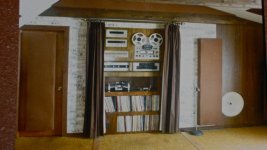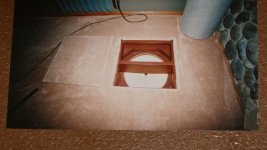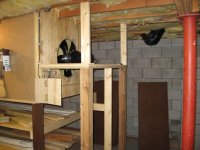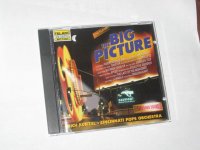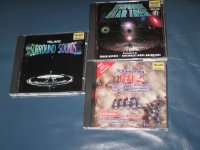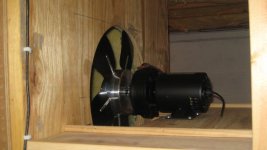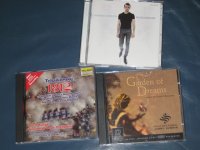My experience with Hartley 24" woofers
I found that the best enclosure for the Hartleys is an
infinite baffle. I originally used a very large closet
for my first Hartley, but later I mounted the woofers
in the floor, using the basement as a infinite baffle.
I also used a Velodyne subwoofer management
system using a 40 hz xover and cutting the bass off
at 15 hz, for protection (necessary in a infinite baffle
to limit excursions below 15 hz. They worked very
well, but now I use a Eminent Technology rotary
subwoofer and the difference is like night and day.
The rotary subwoofer goes to below 1 hz and one
does not need any protection.
I found that the best enclosure for the Hartleys is an
infinite baffle. I originally used a very large closet
for my first Hartley, but later I mounted the woofers
in the floor, using the basement as a infinite baffle.
I also used a Velodyne subwoofer management
system using a 40 hz xover and cutting the bass off
at 15 hz, for protection (necessary in a infinite baffle
to limit excursions below 15 hz. They worked very
well, but now I use a Eminent Technology rotary
subwoofer and the difference is like night and day.
The rotary subwoofer goes to below 1 hz and one
does not need any protection.
Attachments
I have a pair of 12" Pioners under the floor, in a concrete horn that opens to the room. 
It is not about frequency, it is about congruency. Information received through all senses has to be congruent, to believe that it is true. Phase shifts created by woofers and subwoofers destroy congruency, because what body feels is not coherent with what ears hear.
what recording have anything at 1 Hz?
It is not about frequency, it is about congruency. Information received through all senses has to be congruent, to believe that it is true. Phase shifts created by woofers and subwoofers destroy congruency, because what body feels is not coherent with what ears hear.
Recordings with very low bass
Telarc The Big Picture CD-80437, cuts #6 & #7, The Apollo
Mission Very powerful bass between 3 and 5 hz. The
Eminent Technology Rotary Subwoofer makes this recording
sound extremely realistic. Telarc Surround Sounds CD
80447, CUT #1, sound from Jurassick Park, T-REX dinosaur
has bass energy also between 3 and 5 hz. Cut #9, Chiller,
has a thunderclap with extremely low bass transient energy
that it scared the crap out of my wife the first time I played it.
No single conventional subwoofer can do this without destroying
the sub.
Telarc The Big Picture CD-80437, cuts #6 & #7, The Apollo
Mission Very powerful bass between 3 and 5 hz. The
Eminent Technology Rotary Subwoofer makes this recording
sound extremely realistic. Telarc Surround Sounds CD
80447, CUT #1, sound from Jurassick Park, T-REX dinosaur
has bass energy also between 3 and 5 hz. Cut #9, Chiller,
has a thunderclap with extremely low bass transient energy
that it scared the crap out of my wife the first time I played it.
No single conventional subwoofer can do this without destroying
the sub.
Attachments
Hello,
My plan is to have the Hartley speakers as subwoofers on the band of 20 to 250Hz. For the medium and highs I will try to get something close to the HQD system (2 pair of stacked Quad 57's and ruban tweeters).
Thanks,
Best regards
Victor
If memory serves me correct, 100 hz was the correct cut off anything above this would produce 2 much distortion, optimum was 70 hz ...
regards,
Telarc The Big Picture CD-80437, cuts #6 & #7, The Apollo
Mission Very powerful bass between 3 and 5 hz. The
Eminent Technology Rotary Subwoofer makes this recording
sound extremely realistic. Telarc Surround Sounds CD
80447, CUT #1, sound from Jurassick Park, T-REX dinosaur
has bass energy also between 3 and 5 hz. Cut #9, Chiller,
has a thunderclap with extremely low bass transient energy
that it scared the crap out of my wife the first time I played it.
No single conventional subwoofer can do this without destroying
the sub.
fine, but that's not music...
Yep, that's not music, but the infra bass "whispering" is the element that makes perceivable the recording venue size, big concert hall or church for example.
A low bass extension makes also the voices more natural, the treble more balanced...
I would like to hear either these Hartley, either this roto sub.
A low bass extension makes also the voices more natural, the treble more balanced...
I would like to hear either these Hartley, either this roto sub.
Lol, yeah that's why we record voices with low cut filters in the first place...A low bass extension makes also the voices more natural, the treble more balanced...

Lol, yeah that's why we record voices with low cut filters in the first place...
...and that's why more and more often recording engineers on Garslutz forum are asking about properly saturating transformer to make lows "in focus" with the music...
I may guess, if low cut on condenser microphones on voices is engaged, there may be 4 reasons:
1) Microphones are positioned too close,
2) No pop screens for close miking used,
3) No proper shock mounts for microphones
4) High low frequency noises in the studio
Typical nearfield monitors are rated from 50-70 Hz. Some of modern types, like expensive Barefoot monitors, go really low.
Edit: 5) Target audience listens through ipod headphones, computer speakers, car speakers
1) Microphones are positioned too close,
2) No pop screens for close miking used,
3) No proper shock mounts for microphones
4) High low frequency noises in the studio
Typical nearfield monitors are rated from 50-70 Hz. Some of modern types, like expensive Barefoot monitors, go really low.
Edit: 5) Target audience listens through ipod headphones, computer speakers, car speakers
True, the Neve's, MCI's and API's (and others) do have a very nice saturating effect in their transformers that you (maybe) miss in modern consoles like SSL because they have this nice low end 'edge' and the ability to integrate all individual sound into one music piece....and that's why more and more often recording engineers on Garslutz forum are asking about properly saturating transformer to make lows "in focus" with the music...
But even we like the sound it doesn't have anything to do with, I'm quoting, "infra bass "whispering" is the element that makes perceivable the recording venue size" which relates to the natural response from accoustics while saturation is related to an electrical "nice" side effects. So if you use your argument "A low bass extension makes also the voices more natural" based on the saturation story I'm affraid it is a contradiction
1.) Because big membranes can pic up a lot you don't want in (rumble from instruments, LF background noises like wind, plops, contact sounds, electrical interference... whatever causes unwanted LF noise).Interesting remark Djim.
without animosity, but curiosity, can I ask :
1. why low cut on the voices (and what kind of voice/music ?)
2. how low are going the monitors that you use ?
With close miking the proximity effect will boost LF in an unnatural way (and the vocalist can produce unwanted noises). You don't want that or you want it as an (unnatural) effect. But like every type of filter (eq included) they all have their own specific character. Somehow many engineers/producers (even famous ones) seem to forget this while they realise the importance for character in other gear. But it doesn't mean I use them all the time. Like with everything in recording there are no general rules or standards that work in all situations.
Also the room acoustics (mike placing) often 'change' the natural response and as you know low cut filtering often works less damaging as eq-ing.
And another reason can be the unnatural response/character from a mic.
2.) It depends on the location where I work. At home my mixing room is the most limiting factor since it's 8 x 6 x 4,5 meters (but heavily damped below 90Hz).
Last edited:
But even we like the sound it doesn't have anything to do with, I'm quoting, "infra bass "whispering" is the element that makes perceivable the recording venue size" which relates to the natural response from accoustics while saturation is related to an electrical "nice" side effects. So if you use your argument "A low bass extension makes also the voices more natural" based on the saturation story I'm affraid it is a contradiction.
No, it is not a contradiction. It had been proven recently by number of researches that in sound reproduction waveform preservation means more than simple preservation of harmonic content. Transformer saturation on lows is absolutely different thing from rolling off lows using either R-C, or L-R differentiating networks. Limiting lows, saturated transformers preserve phase of lows (even make it more "focused"!), adding extra harmonics as well.
I mentioned below already congruency of perceived by sensors information.
What is congruency?
For example, when somebody says, "I am happy", but you see that his face looks like he is sad, it is called incongruency: what you perceive by your senses does not match, so you don't believe that the person said the truth. But when you don't see the person you may believe that what he says is truth. No information perceived that shows that it is not congruent, it is not the truth. You reconstruct that person in your imagination, and his image is coherent with his words.
The same way, when your body perceives bass shifted by phase from harmonics your ears hear, you don't believe the sound is real. But when your body perceives nothing, your ears and brain are free to reconstruct fundamentals hearing harmonics, according to the imagination. Also, when speakers can not reproduce bass additional distortions make you believe that you hear it.
I myself personally prefer high-end reproduction of breeze recorded in the field. But that needs very wide frequency band. Wider than 20-20,000 Hz, because otherwise phase shifts on both ends make sound using the term of audio engineers "unfocused", using my terminology, incongruent.
I found that the best enclosure for the Hartleys is an
infinite baffle. I originally used a very large closet
for my first Hartley, but later I mounted the woofers
in the floor, using the basement as a infinite baffle.
I also used a Velodyne subwoofer management
system using a 40 hz xover and cutting the bass off
at 15 hz, for protection (necessary in a infinite baffle
to limit excursions below 15 hz. They worked very
well, but now I use a Eminent Technology rotary
subwoofer and the difference is like night and day.
The rotary subwoofer goes to below 1 hz and one
does not need any protection.
Thanks a lot for your recommendations and pictures. This help me to decide in the way to go.
You may find this thread useful:
http://www.diyaudio.com/forums/multi-way/106532-enclosures-hartley-24-a-2.html
Thank you Dr Dyna, m R g S R, tb46 for all the comments and information. It seems that I need more advice that I though. I will come latter with other questions.
Regards
Music Recordings with bass
Tchaikovsky 1812 Overature is music with cannons
that have transient bass energy (below 3 hz). Conventional woofers can not reproduce without
serious distortion. Pipe organs have frequency
response to 16 hz and some down to 8 hz. Reference
Recordings RR-108 Garden of Dreams Cut #11 has
a sustained 16 hz note for a very long time. The Hartley 24" woofers could play this recording, but at a much reduced level.
However the rotary subwoofer has no problems and reproduces
these recordings with awesome power and is easy to hear the
difference in quality.
fine, but that's not music...
Tchaikovsky 1812 Overature is music with cannons
that have transient bass energy (below 3 hz). Conventional woofers can not reproduce without
serious distortion. Pipe organs have frequency
response to 16 hz and some down to 8 hz. Reference
Recordings RR-108 Garden of Dreams Cut #11 has
a sustained 16 hz note for a very long time. The Hartley 24" woofers could play this recording, but at a much reduced level.
However the rotary subwoofer has no problems and reproduces
these recordings with awesome power and is easy to hear the
difference in quality.
Attachments
- Status
- This old topic is closed. If you want to reopen this topic, contact a moderator using the "Report Post" button.
- Home
- Loudspeakers
- Subwoofers
- 24" hartley photos -
